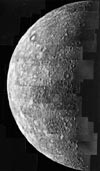
| Bad Astronomy |
|
|
|
BA Blog
|
|
Q & BA
|
|
Bulletin Board
|
| Media |
|
|
|
Bitesize Astronomy
|
|
Bad Astro Store
|
|
Mad Science
|
|
Fun Stuff
|
| Site Info |
|
|
|
Links
|
| RELATED SITES |
| - Universe Today |
| - APOD |
| - The Nine Planets |
| - Mystery Investigators |
| - Slacker Astronomy |
| - Skepticality |
Buy My Stuff

Keep Bad Astronomy close to your heart, and help make me
filthy rich. Hey, it's either this or one of those really
irritating PayPal donation buttons here.
Locking in Mercury's Day
Week of July 28, 1997
 For a long time, the planet Mercury was a mystery. Studying it through
telescopes was (and still is!) difficult because it is so close
to the Sun. However, in 1974, the space probe Mariner 10 was
sent to the tiny planet to photograph the surface. Surprisingly, Mercury was
covered with craters, much like the Moon. But even before then, a surprising
fact about Mercury was revealed: radar was used to determine the rotation
period, and it was found to be 2/3 of its year, exactly!
For a long time, the planet Mercury was a mystery. Studying it through
telescopes was (and still is!) difficult because it is so close
to the Sun. However, in 1974, the space probe Mariner 10 was
sent to the tiny planet to photograph the surface. Surprisingly, Mercury was
covered with craters, much like the Moon. But even before then, a surprising
fact about Mercury was revealed: radar was used to determine the rotation
period, and it was found to be 2/3 of its year, exactly!
It was thought before the radar experiments that Mercury's day would be exactly as long as its year. The reason for this is because of a complicated effect of gravity (called tides, it's the same effect that has locked the Earth's Moon into rotating once every time it revolves around the Earth, always showing the same face to us). No one had suspected that Mercury would rotate in any other way, but after the fact scientists realized that a 3:2 rotation to revolution ratio is not much less likely than a 1:1 ratio like our Moon has.
 There is another thing about Mercury's orbit that's important too: it is
fairly elliptical, which means that sometimes Mercury is a bit closer
to the Sun that other times. But since Mercury's rotation is locked into
its orbital period, the same spot is facing the Sun every other orbit.
In other words, there is a spot on Mercury that is directly facing the Sun
every second orbit, when Mercury reaches its closest point to the Sun.
If you were to stand on that spot on the surface, you would suffer for it:
Every second year the Sun would reach the zenith, but it would also
look larger than usual because it is so close. You have the misfortune
of picking the hottest spot on the planet!
When Mariner 10 imaged Mercury, a tremendous impact crater was found at just
that spot on the surface. It was named "Caloris Basin", or Basin of Heat,
for that very reason! In the image above from Mariner 10
you can see the edge of Caloris
Basin as a series of concentric arcs coming out from the dark side of the
planet.
There is another thing about Mercury's orbit that's important too: it is
fairly elliptical, which means that sometimes Mercury is a bit closer
to the Sun that other times. But since Mercury's rotation is locked into
its orbital period, the same spot is facing the Sun every other orbit.
In other words, there is a spot on Mercury that is directly facing the Sun
every second orbit, when Mercury reaches its closest point to the Sun.
If you were to stand on that spot on the surface, you would suffer for it:
Every second year the Sun would reach the zenith, but it would also
look larger than usual because it is so close. You have the misfortune
of picking the hottest spot on the planet!
When Mariner 10 imaged Mercury, a tremendous impact crater was found at just
that spot on the surface. It was named "Caloris Basin", or Basin of Heat,
for that very reason! In the image above from Mariner 10
you can see the edge of Caloris
Basin as a series of concentric arcs coming out from the dark side of the
planet.
|
|
| THE PANTRY: ARCHIVE OF BITESIZE SNACKS |
|
|
| Subscribe to the Bad Astronomy Newsletter! |
| Talk about Bad Astronomy on the BA Bulletin Board! |